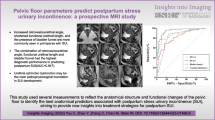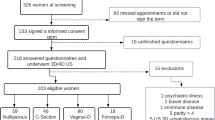Abstract
Introduction and hypothesis
The objective was to evaluate the morphological characteristics of pelvic floor structure specific to de novo stress urinary incontinence (SUI) in primiparous women using three-dimensional (3D) reconstruction fusion technology based on static MRI combined with dynamic MRI.
Methods
Eighty-one primiparous women after the first vaginal delivery were studied, 40 with SUI and 41 without SUI. 3D reconstruction models based on static MRI were used to describe the anatomical abnormalities of pelvic floor tissues. Dynamic MRI was used to describe segmental activities of the urethra and vagina. The relationship between the morphometry and postpartum SUI was evaluated by logistic regression analysis and receiver operator characteristic curve.
Results
The differences in the distance from the bladder neck to the pubic symphysis (BSD), the angle between the posterior wall of the urethra and the anterior wall of the vagina, the width of the distal region of the vagina, urethral length, urethral compression muscle volume (CUV), and pubovisceral muscle volume, puborectal muscle volume, were measured, and except for the extremity of the anterior urethral wall, the total displacements (TDs) of the other sites between the two groups were statistically significant (p < 0.05). Logistic regression analysis showed that the BSD decreased, the CUV decreased, the TDs of the first site and the eighth site increment correlated significantly with postpartum SUI occurrence (p < 0.05).
Conclusions
3D reconstruction fusion technology provides an important support for a precise assessment of the pelvic floor dysfunction. The BSD, CUV, and iliococcygeus muscle volume have certain values in predicting de novo SUI after first vaginal birth.




Similar content being viewed by others
Data Availability
The data are not publicly available due to their containing information that could compromise the privacy of research participants. This study includes data and imaging from participants. For reasons of reverence, datasets used and/or analysed during the current study are available from the corresponding author on reasonable request.
References
Capobianco G, Madonia M, Morelli S, et al. Management of female stress urinary incontinence: a care pathway and update. Maturitas. 2018;109:32–8. https://doi.org/10.1016/j.maturitas.2017.12.008.
MacLennan AH, Taylor AW, Wilson DH, Wilson D. The prevalence of pelvic floor disorders and their relationship to gender, age, parity and mode of delivery. Br J Obstet Gynaecol. 2000;107(12):1460–70. https://doi.org/10.1111/j.1471-0528.2000.tb11669.x.
DeLancey JO, Miller JM, Kearney R, et al. Vaginal birth and de novo stress incontinence: relative contributions of urethral dysfunction and mobility. Obstet Gynecol. 2007;110(2 Pt 1):354–62. https://doi.org/10.1097/01.Aog.0000270120.60522.55.
Li N, Cui C, Cheng Y, et al. Association between magnetic resonance imaging findings of the pelvic floor and de novo stress urinary incontinence after vaginal delivery. Korean J Radiol. 2018;19(4):715–23. https://doi.org/10.3348/kjr.2018.19.4.715.
Garriga JC, Isern AP, Carballeira MR, et al. Three-dimensional translabial ultrasound assessment of urethral supports and the urethral sphincter complex in stress urinary incontinence. Neurourol Urodyn. 2017;36(7):1839–45. https://doi.org/10.1002/nau.23193.
Peker H, Peker BH. 3D high frequency endovaginal ultrasound evaluation of urethral and pelvic morphology in stress urinary incontinence in first pregnancy. Eur J Obstet Gynecol Reprod Biol. 2021;261:148–53. https://doi.org/10.1016/j.ejogrb.2021.04.037.
Feng YK, Wu JH, Zhu H, et al. Three-dimensional measurement and analysis of benign prostatic hyperplasia. Transl Androl Urol. 2021;10(6):2384–96. https://doi.org/10.21037/tau-21-142.
Feng YK, Zhang SJ, Zhou Y, et al. Three-dimensional measurement and analysis of morphological parameters of the uterus in infertile women. Quant Imaging Med Surg. 2022;12(4):2224–37. https://doi.org/10.21037/qims-21-812.
Shi Q, Wen L, Zhao B, Huang S, Liu D. The association of hiatal dimensions and urethral mobility with stress urinary incontinence. J Ultrasound Med. 2022;41(3):671–7. https://doi.org/10.1002/jum.15748.
Shek KL, Dietz HP. The urethral motion profile: a novel method to evaluate urethral support and mobility. Aust N Z J Obstet Gynaecol. 2008;48(3):337–42. https://doi.org/10.1111/j.1479-828X.2008.00877.x.
Zhao B, Wen L, Liu D, Huang S. Urethral configuration and mobility during urine leaking described using real-time transperineal ultrasonography. Ultrasonography. 2022;41(1):171–6. https://doi.org/10.14366/usg.21058.
Reiner CS, Weishaupt D. Dynamic pelvic floor imaging: MRI techniques and imaging parameters. Abdom Imaging. 2013;38(5):903–11. https://doi.org/10.1007/s00261-012-9857-7.
Kim JK, Kim YJ, Choo MS, Cho KS. The urethra and its supporting structures in women with stress urinary incontinence: MR imaging using an endovaginal coil. Am J Roentgenol. 2003;180(4):1037–44. https://doi.org/10.2214/ajr.180.4.1801037.
Sheng Y, Liu XF, Low LK, Ashton-Miller JA, Miller JM. Association of pubovisceral muscle tear with functional capacity of urethral closure: evaluating maternal recovery from labor and delivery. Am J Obstet Gynecol. 2020;222(6):598.e1–7. https://doi.org/10.1016/j.ajog.2019.11.1257.
Murad-Regadas SM, Fernandes GOD, Regadas FSP, et al. Usefulness of anorectal and endovaginal 3D ultrasound in the evaluation of sphincter and pubovisceral muscle defects using a new scoring system in women with fecal incontinence after vaginal delivery. Int J Colorectal Dis. 2017;32(4):499–507. https://doi.org/10.1007/s00384-016-2750-z.
Yasar L, Telci SO, Dogan K, Kaya E, Ekin M. Predictive role of measurement of pelvic floor muscle thickness with static MRI in stress and mixed urinary incontinence. Int Urogynecol J. 2019;30(2):271–7. https://doi.org/10.1007/s00192-018-3663-x.
Singh K, Reid WM, Berger LA. Magnetic resonance imaging of normal levator ani anatomy and function. Obstet Gynecol. 2002;99(3):433–8. https://doi.org/10.1016/s0029-7844(01)01743-4.
Mothes AR, Mothes HK, Kather A, et al. Inverse correlation between urethral length and continence before and after native tissue pelvic floor reconstruction. Sci Rep. 2021;11(1):22011. https://doi.org/10.1038/s41598-021-01565-z.
Feng Y, Wu J, Zhu H, et al. Three-dimensional measurement and analysis of benign prostatic hyperplasia. Transl Androl Urol. 2021;10(6):2384–96. https://doi.org/10.21037/tau-21-142.
Hol M, van Bolhuis C, Vierhout ME. Vaginal ultrasound studies of bladder neck mobility. Br J Obstet Gynaecol. 1995;102(1):47–53. https://doi.org/10.1111/j.1471-0528.1995.tb09025.x.
Mayer R, Wells TJ, Brink CA, Clark P. Correlations between dynamic urethral profilometry and perivaginal pelvic muscle activity. Neurourol Urodyn. 1994;13(3):227–35. https://doi.org/10.1002/1520-6777(1994)13:3<227::aid-nau1930130304>3.0.co;2-a.
Yin YT, **a ZJ, Feng XY, Luan M, Qin MY. Three-dimensional transperineal ultrasonography for diagnosis of female occult stress urinary incontinence. Med Sci Monit. 2019;25:8078–83. https://doi.org/10.12659/msm.917086.
Dietz HP, Clarke B, Herbison P. Bladder neck mobility and urethral closure pressure as predictors of genuine stress incontinence. Int Urogynecol J Pelvic Floor Dysfunct. 2002;13(5):289–93. https://doi.org/10.1007/s001920200063.
Pipitone F, Sadeghi Z, DeLancey JOL. Urethral function and failure: a review of current knowledge of urethral closure mechanisms, how they vary, and how they are affected by life events. Neurourol Urodyn. 2021;40(8):1869–79. https://doi.org/10.1002/nau.24760.
Wang Y, Yao J, Chen N, Liu J, Shi G, Wu Y. Study of female pelvic floor muscle in overactive bladder based on MRI 3D reconstruction. BMC Urol. 2022;22(1):132. https://doi.org/10.1186/s12894-022-01090-9.
Yucel S, Baskin LS. An anatomical description of the male and female urethral sphincter complex. J Urol. 2004;171(5):1890–7. https://doi.org/10.1097/01.ju.0000124106.16505.df.
Zhao BH, Wen LM, Liu D, Huang SY. Visualized urethral mobility profile during urine leakage in supine and standing positions. Ultraschall Med. 2023;44(3):e158–63. https://doi.org/10.1055/a-1700-2862.
Jun T, Yoon HS, Kim HS, Lee JW, Bae J, Lee HW. Recurrence rate of stress urinary incontinence in females with initial cure after transobturator tape procedure at 3-year follow-up. Investig Clin Urol. 2017;58(1):54–60. https://doi.org/10.4111/icu.2017.58.1.54.
Nikolopoulos KI, Betschart C, Doumouchtsis SK. The surgical management of recurrent stress urinary incontinence: a systematic review. Acta Obstet Gynecol Scand. 2015;94(6):568–76. https://doi.org/10.1111/aogs.12625.
Tian D, Gao Z, Zhou H, et al. A comparative study on the clinical efficacy of simple transobturator midurethral sling and posterior pelvic floor reconstruction. Medicina (Kaunas). 2023;59(1):155. https://doi.org/10.3390/medicina59010155.
DeLancey JO. Structural support of the urethra as it relates to stress urinary incontinence: the hammock hypothesis. Am J Obstet Gynecol. 1994;170(6):1713–20. https://doi.org/10.1016/s0002-9378(94)70346-9. discussion 1720–3.
Funding
This study was funded by grants from the National Natural Science Foundation of China (31871212, Lidong Zhai).
Author information
Authors and Affiliations
Contributions
L. Shi: project development, data collection, manuscript writing; Y. Zhao: data collection, manuscript writing; W. Li: data analysis, manuscript writing; L. Chen: data collection, manuscript writing; W. Shen: data collection, manuscript writing; L. Zhai: administrative support, data collection, manuscript writing.
Corresponding authors
Ethics declarations
Ethical statement
The authors are accountable for all aspects of the work in ensuring that questions related to the accuracy or integrity of any part of the work are appropriately investigated and resolved. The study was conducted in accordance with the Declaration of Helsinki (as revised in 2013). The study was approved by the Institutional Review Board (IRB) of Tian** first central hospital (registration ID2018NO22KY).
Conflicts of interest
None.
Additional information
Publisher's Note
Springer Nature remains neutral with regard to jurisdictional claims in published maps and institutional affiliations.
Supplementary information
Below is the link to the electronic supplementary material.
Rights and permissions
Springer Nature or its licensor (e.g. a society or other partner) holds exclusive rights to this article under a publishing agreement with the author(s) or other rightsholder(s); author self-archiving of the accepted manuscript version of this article is solely governed by the terms of such publishing agreement and applicable law.
About this article
Cite this article
Shi, L., Zhao, Y., Li, W. et al. Evaluation of pelvic structural abnormalities in primiparous women with stress urinary incontinence. Int Urogynecol J 35, 369–380 (2024). https://doi.org/10.1007/s00192-023-05675-2
Received:
Accepted:
Published:
Issue Date:
DOI: https://doi.org/10.1007/s00192-023-05675-2




